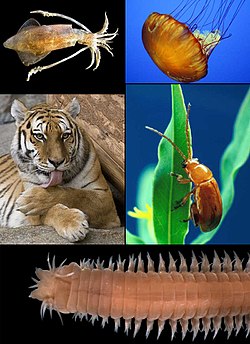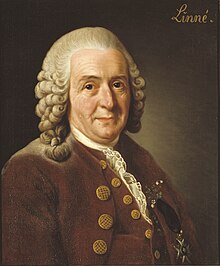| Revision as of 13:15, 11 September 2007 view sourceTablelajk3 (talk | contribs)12 editsNo edit summary← Previous edit | Revision as of 13:15, 11 September 2007 view source Tablelajk3 (talk | contribs)12 edits →LophotrochozoaNext edit → | ||
| Line 98: | Line 98: | ||
| ===Lophotrochozoa=== | |||
| ] | |||
| The ] include two of the most successful animal phyla, the ] and ]. The former includes animals such as ]s, ]s, and ]s, and the latter comprises the segmented worms, such as ]s and ]es. These two groups have long been considered close relatives because of the common presence of ] larvae, but the annelids were considered closer to the arthropods, because they are both segmented. Now this is generally considered ], owing to many morphological and genetic differences between the two phyla. | |||
| The Lophotrochozoa also include the ] or ribbon worms, the ], and several phyla that have a fan of cilia around the mouth, called a ]. These were traditionally grouped together as the lophophorates, but it now appears they are ], some closer to the Nemertea and some to the Mollusca and Annelida. They include the ] or lamp shells, which are prominent in the fossil record, the ], the ], and possibly the ] or moss animals. | |||
| == Model organisms == | == Model organisms == | ||
Revision as of 13:15, 11 September 2007
| This article needs additional citations for verification. Please help improve this article by adding citations to reliable sources in this article. Unsourced material may be challenged and removed. Find sources: "Animal" – news · newspapers · books · scholar · JSTOR (July 2007) (Learn how and when to remove this message) |
| Animals Temporal range: Ediacaran - Recent | |
|---|---|

| |
| Clockwise from top-left: Loligo vulgaris (a mollusk), Chrysaora quinquecirrha (a cnidarian), Aphthona flava (an arthropod), Eunereis longissima (an annelid), and Panthera tigris (a chordate). | |
| Scientific classification | |
| Domain: | Eukaryota |
| (unranked): | Opisthokonta |
| Kingdom: | Animalia Linnaeus, 1758 |
| Phyla | |
|
Subregnum Parazoa (alternatively)
| |

Animals are a major group of organisms, classified as the kingdom Animalia or Metazoa. In general they are multicellular, responsive to their environment, and feed by consuming other organisms or parts of them. Their body plan becomes fixed as they develop, usually early on in their development as embryos, although some undergo a process of metamorphosis later on.
The word "animal" comes from the Latin word animal, of which animalia is the plural, and is derived from anima, meaning vital breath or soul. In everyday colloquial usage, the word usually refers to non-human animals. The biological definition of the word refers to all members of the Kingdom Animalia. Therefore, when the word "animal" is used in a biological context, humans are included.
Groups of animals
The sponges (Porifera) diverged from other animals early. As mentioned above, they lack the complex organization found in most other phyla. Their cells are differentiated, but in most cases not organized into distinct tissues. Sponges are sessile and typically feed by drawing in water through pores. Archaeocyatha, which have fused skeletons, may represent sponges or a separate phylum.
Among the eumetazoan phyla, two are radially symmetric and have digestive chambers with a single opening, which serves as both the mouth and the anus. These are the Cnidaria, which include sea anemones, corals, and jellyfish, and the Ctenophora or comb jellies. Both have distinct tissues, but they are not organized into organs. There are only two main germ layers, the ectoderm and endoderm, with only scattered cells between them. As such, these animals are sometimes called diploblastic. The tiny Placozoans are similar, but they do not have a permanent digestive chamber.
The remaining animals form a monophyletic group called the Bilateria. For the most part, they are bilaterally symmetric, and often have a specialized head with feeding and sensory organs. The body is triploblastic, i.e. all three germ layers are well-developed, and tissues form distinct organs. The digestive chamber has two openings, a mouth and an anus, and there is also an internal body cavity called a coelom or pseudocoelom. There are exceptions to each of these characteristics, however - for instance adult echinoderms are radially symmetric, and certain parasitic worms have extremely simplified body structures.
Genetic studies have considerably changed our understanding of the relationships within the Bilateria. Most appear to belong to four major lineages:
In addition to these, there are a few small groups of bilaterians with relatively similar structure that appear to have diverged before these major groups. These include the Acoelomorpha, Rhombozoa, and Orthonectida. The Myxozoa, single-celled parasites that were originally considered Protozoa, are now believed to have developed from the Bilateria as well.
Model organisms
Because of the great diversity found in animals, it is more economical for scientists around the world concert their efforts on a small number of chosen species so that connections can be drawn from their work and conclusions extrapolated about how animals function in general. Because they are easy to keep and breed, the fruit fly Drosophila melanogaster and the nematode Caenorhabditis elegans have long been the most intensively studied metazoan model organism, and among the first lifeforms to be genetically sequenced. This was facilitated by the severely reduced state of their genomes, but the double-edged sword here is that with many genes, introns and linkages lost, these ecdysozoans can teach us little about the origins of animals in general. The extent of this type of evolution within the superphylum will be revealed by the crustacean, annelid, and molluscan genome projects currently in progress. Analysis of the starlet sea anemone genome has emphasised the importance of sponges, placozoans, and choanoflagellates, also being sequenced, in explaining the arrival of 1500 ancestral genes unique to the Eumetazoa.
An analyse of the homoscleromorph sponge Oscarella carmela also suggests that the last common ancestor of sponges and the eumetazoan animals were more comlex than previously assumed.
History of classification

Aristotle divided the living world between animals and plants, and this was followed by Carolus Linnaeus in the first hierarchical classification. Since then biologists have begun emphasizing evolutionary relationships, and so these groups have been restricted somewhat. For instance, microscopic protozoa were originally considered animals because they move, but are now treated separately.
In Linnaeus' original scheme, the animals were one of three kingdoms, divided into the classes of Vermes, Insecta, Pisces, Amphibia, Aves, and Mammalia. Since then the last four have all been subsumed into a single phylum, the Chordata, whereas the various other forms have been separated out. The above lists represent our current understanding of the group, though there is some variation from source to source.
See also
- Fauna
- List of animal names
- Animal behavior
- Animal rights
- List of animals by number of neurons
- Holocene extinction event
References
-
N.H. Putnam; et al. (2007). "Sea anemone genome reveals ancestral eumetazoan gene repertoire and genomic organization". Science. 317 (5834): 86–94. doi:10.1126/science.1139158.
{{cite journal}}: Explicit use of et al. in:|author=(help); Unknown parameter|month=ignored (help) - Mitochondrial Genome of the Homoscleromorph Oscarella carmela (Porifera, Demospongiae) Reveals Unexpected Complexity in the Common Ancestor of Sponges and Other Animals Oxford Journals
- Klaus Nielsen. Animal Evolution: Interrelationships of the Living Phyla (2nd edition). Oxford Univ. Press, 2001.
- Knut Schmidt-Nielsen. Animal Physiology: Adaptation and Environment. (5th edition). Cambridge Univ. Press, 1997.
External links
- Tree of Life Project
- Animal Diversity Web - University of Michigan's database of animals, showing taxonomic classification, images, and other information.
- ARKive - multimedia database of worldwide endangered/protected species and common species of UK.
- Scientific American Magazine (December 2005 Issue) - Getting a Leg Up on Land About the evolution of four-limbed animals from fish.
| Elements of nature | |||||
|---|---|---|---|---|---|
| Universe | |||||
| Earth | |||||
| Weather | |||||
| Natural environment | |||||
| Life | |||||
| See also | |||||